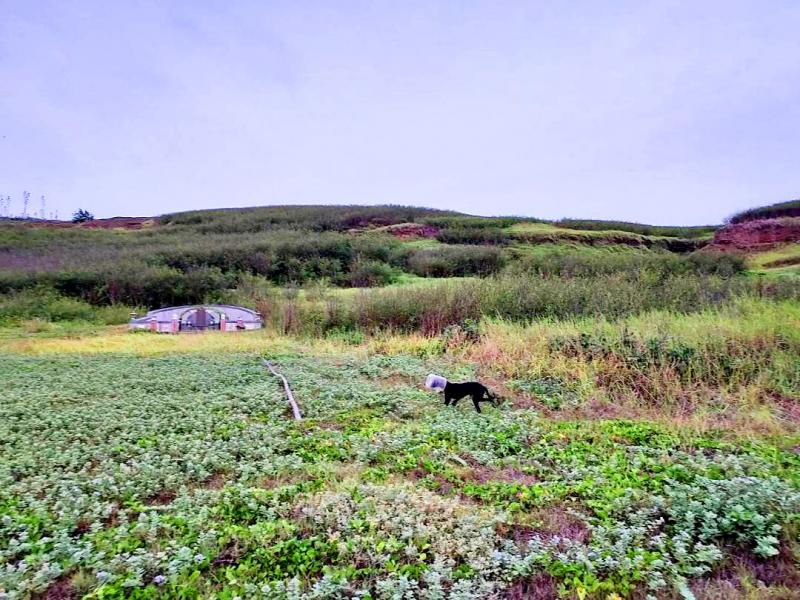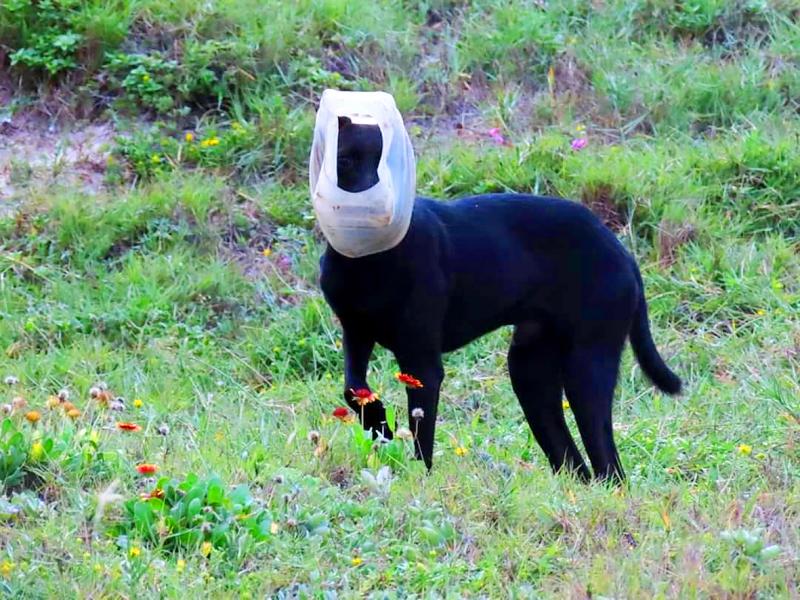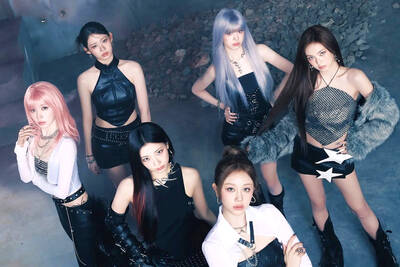A stray dog that was recently spotted at the Fifth Public Cemetery in Penghu County’s Siyu Township wearing a large plastic bottle on its head has been dubbed “bottle knight” due to its unusual appearance. Although many people have tried to approach the stay dog, it is frightened of humans and quickly moves away whenever anyone gets close. Fearing that the dog’s life was in danger, some members of the public called the Penghu County Animal Disease Control Center, which sent some of its expert staff to provide assistance.
Thanks to the Fifth Public Cemetery’s close proximity to the coastline and a beach, members of the public spotted the stray dog toward the end of last month. Many people subsequently joked that the dog had fashioned protective equipment for itself in response to the nationwide COVID-19 level 3 alert. Joking aside, the bottle had encased the dog’s whole head, preventing it from foraging for food or drinking water. Realizing that something was amiss and concerned that the dog could easily die of malnutrition, Yen Jen-yu, who runs a local water sports and recreation business, contacted local writer and historian Yen Tung-hsing and asked him to help out by taking some professional photographs to post online and appeal for assistance.
Although many members of the public have since tried to approach “bottle knight,” the stray dog is highly vigilant and stays at least 2m away from people, and it runs away from anyone who tries to get close enough to remove the bottle. The Penghu County Animal Disease Control Center dispatched a specialist blow pipe team to the area to try to capture the dog using tranquillizer darts, but they were unsuccessful.

Photo courtesy of Yen Tung-hsing 照片:顏東星提供
Yen Tung-hsing recently returned to the area and, having come across the dog again, used his camera to take some photographs of its current condition. He discovered that the bottle was still firmly lodged on the dog’s head but the plastic had crumpled noticeably, suggesting that the dog had tried hard to extricate itself from the bottle’s constraints. Yen observed that although the dog had been wearing the bottle for many days, it actually seemed to be in quite good condition and was moving about nimbly. Yen suspected someone might be feeding the dog behind the scenes, but wondered, if so, why they would not help it to remove the bottle from its head. Yen Tung-hsing suggested that they might be worried about being bitten. There were still many unanswered questions, he added.
(Liberty Times, translated by Edward Jones)
澎湖縣西嶼鄉第五公墓附近坡地,新近出現一隻「水桶俠」流浪狗,頭戴著塑膠水桶,造型相當奇特。雖然多人試圖接近,但水桶俠相當怕人,稍微接近就迅速離開。民眾擔心危及生命,因此求助於專業的澎湖家畜疾病防治所派員處理。

Photo courtesy of Yen Tung-hsing 照片:顏東星提供
鄰近海岸線及沙灘的第五公墓,早在上個月下旬,就有民眾發現頭戴水桶的浪浪,不少人以為是全國三級警戒下的防疫新裝備。但玩笑歸玩笑,整個水桶罩住浪浪頭部,根本無法覓食及飲水,很容易造成浪浪營養不良死亡,當地水上樂園遊憩業者顏任佑發現不對勁,透過文史工作者顏東星以專業相機拍攝照片,上網對外求援。
雖然許多民眾曾企圖接近水桶俠,但浪浪始終保持高度警戒,並維持兩公尺距離,再靠近一點就跑掉了,因此無法靠近,協助脫離水桶控制。澎湖家畜疾病防治所出動專業吹箭隊前往捕捉,但也都無所獲。
顏東星近日重返故地,再度與水桶俠浪浪狹路相逢,並用相機快門拍下近況,發現水桶俠仍是頭不離桶,但塑膠製的水桶明顯凹陷,顯示浪浪曾盡力想脫離水桶的控制,雖然浪浪以頭罩水桶多日,身體狀況還相當良好,動作也十分敏捷,因此懷疑幕後有人在餵養。只是令外界好奇的是,為何不幫水桶俠取下水桶?還是擔憂水桶俠會咬人,留下種種疑團待解。
(自由時報劉禹慶)

詞法—不定詞的誤用 1. 我得記住星期五要把報告寫好。 ˇ I must remember to finish my report by Friday. χ I must remember finishing my report by Friday. 註︰remember 後面跟動名詞或不定詞表示兩種不同的概念,與 forget 相類似。 試比較下列句子: I remember meeting him somewhere.(我記得曾經在某處見過他。) I must remember to meet him at the station at six this evening. (我必須記住今晚六點得去車站接他。) He remembered turning off the light when he left the room. (他記得離開房間時曾先把燈熄了。) Remember to turn off the light when you leave the room. (記住離開房間時要把燈關了。) 2. 他提醒她做好她份內的事。 ˇ He reminded her to do her job. χ He reminded her of doing her job. 註︰remind ... of ... 後面跟動名詞,表示「使人想起做過某事」。若是「提醒某人應做某事」,應用 remind ... to do ...。試比較下列句子: He reminded me of my attending the lecture last Friday. (他讓我想起我上星期五去聽過那次演講。) He

★ Bilingual Story is a fictionalized account. 雙語故事部分內容純屬虛構。 “Any New Year’s resolutions?” he asked. Lena put her coffee down. “Yeah,” she said. “To get in shape.... round is a shape, right?” Mark chuckled. “I support this. Fully achievable. Low risk.” “Thanks,” she smiled and lovingly rubbed her round belly. “I like a resolution I can’t fail.” “Funny thing is, I was thinking about getting round too.” Lena nodded her head in approval, “You could put some meat on those skinny bones of yours.” Mark shook his head, “Not that kind of round. Wheel-of-Life round.” She raised an eyebrow.

A: Apart from Taiwan’s A-mei, Mayday and Jolin Tsai, there are many foreign singers coming to Taiwan early this year. B: The South Korean girl group Babymonster are playing two shows at Taipei Arena starting from tonight. Who else is coming to Taiwan? A: Other artists include Australian band Air Supply, K-pop superstar Rain, boy group Super Junior, TXT, US singers Giveon and Josh Groban, and Irish boy group Westlife. B: Air Supply was the first foreign band to come to Taiwan in 1983, and they’re probably the most frequently visiting group too. A: As the year is beginning

對話 Dialogue 清清:最近天氣越來越冷,感覺很容易感冒,要不要一起去吃薑母鴨或是羊肉爐? Qīngqing: Zuìjìn tiānqì yuèláiyuè lěng, gǎnjué hěn róngyì gǎnmào, yào bú yào yìqǐ qù chī jiāngmǔyā huòshì yángròulú? 華華:最近我覺得有點累,想吃薑母鴨,可是又怕一下子吃太補會上火。 Huáhua: Zuìjìn wǒ juéde yǒudiǎn lèi, xiǎng chī jiāngmǔyā, kěshì yòu pà yíxiàzi chī tài bǔ huì shànghuǒ. 清清:那我們去喝香菇雞湯吧,不太容易上火,喝了也會很暖和。 Qīngqing: Nà wǒmen qù hē xiānggū jītāng ba, bú tài róngyì shànghuǒ, hē le yě huì hěn nuǎnhuo. 華華:聽起來不錯!你們家平常冬天都吃什麼進補? Huáhua: Tīng qǐlái búcuò! Nǐmen jiā píngcháng dōngtiān dōu chī shénme jìnbǔ? 清清:我家都煮麻油雞,吃完整個人手腳都會熱起來。我也很久沒喝香菇雞湯了,正好可以去打打牙祭。 Qīngqing: Wǒ jiā dōu zhǔ máyóujī, chī wán zhěnggè rén shǒujiǎo dōu huì rè qǐlái. Wǒ yě hěn jiǔ méi hē xiānggū jītāng le, zhènghǎo kěyǐ qù dǎ dǎ yájì. 華華:可是我最近在減肥,會不會吃得太補,肉又長回來了? Huáhua: Kěshì wǒ zuìjìn zài jiǎnféi, huì bú